The GP-Probe NANO L1 is a compact GNSS jamming detector that helps you quickly identify interference in the GPS L1 band. The device is very easy to use — it has only one button and a LED scale that shows the interference power level in real time.
All you need to do is switch it on, and it will immediately start beeping and vibrating whenever a jammer is detected.
The GP-Probe NANO L1 has two operating modes: Detector Mode and Logger Mode. From the factory, the device is set to Detector Mode by default.
1. Quick Start Steps
1. Power On the Device
- Press the button briefly and release it.
- Then press and hold the button until the LED scale lights up from bottom to top.
- This means the device is switching on.
- Once active, it will automatically vibrate and beep whenever interference is detected.
2. (Optional) Install the Android App
- Download and install the GPSPATRON Connect app on your Android smartphone:
https://play.google.com/store/apps/details?id=com.gpspatron.connect&pcampaignid=web_share
- Connect the detector via USB Type-C to adjust detection thresholds (make it more or less sensitive) and to perform detailed analysis of interference data.
3. (Recommended) Watch the Introductory Video
To better understand how to use the GP-Probe NANO L1, we highly recommend watching this short video:
4. (Optional) Review the Datasheet
For complete technical specifications, see the datasheet:
? GP-Probe NANO L1 Datasheet
This step is not required for quick use but can be helpful if you want to learn about device limits and advanced capabilities.
2. How to Check Device Status
You can easily check whether the device is working and determine its current mode by looking at the lowest LED on the scale:
- Blinks once per second → the device is active in Detector Mode.
- Blinks once every 3 seconds → the device is active in Logger Mode.
- No blinking → the device is switched off.
This simple indication makes it possible to confirm the device status at any time without connecting to a smartphone.

3. Powering On and Off
The GP-Probe NANO L1 is controlled with a single button. Turning the device on or off is very simple:
- To switch on
- Quickly press and release the button.
- Then press and hold the button again for a couple of seconds.
- The LED scale will light up from bottom to top — this means the device is powering on.

- To switch off
- Quickly press and release the button.
- Then press and hold it again.
- The LED scale will light up from top to bottom — this means the device is shutting down.
This visual animation on the LED scale helps you immediately understand whether the device is being turned on (lights grow upward) or off (lights fall downward).

4. GPSPATRON Connect App
For more detailed data analysis and configuration, you can use the GPSPATRON Connect application. It can be installed on any Android smartphone. The detector connects to the phone via a USB Type-C port.
When the GP-Probe NANO L1 operates in Detector Mode and is connected to the app, you will see:
A real-time power graph of interference measurements.
GNSS signal quality indicators (SNR) coming from your smartphone’s GNSS receiver.
This allows you to analyze data more conveniently and quickly localize the source of interference.

Inside the app, you can configure the following parameters:
Threshold (dBm)
Sets how sensitive the detector is.
Example: if set to –90 dBm, the detector will trigger when interference is stronger than this level.
Lower (–95) = more sensitive, detects weaker signals, but may cause false alerts.
Higher (–85) = less sensitive, useful near industrial noise.
Recommended starting value: –90 dBm.
Alert Duration (seconds)
Defines how long the alert remains active after interference is detected.
Even if the interference disappears, the LEDs, vibration, or sound will stay active for the set time.
Example: if set to 10 sec, the alarm continues for 10 seconds after detection.
Notification Type
LED Scale – always active, shows interference power from weak to strong.
Vibration Alert – discreet notification (good for silent use).
Sound Alert – short beep when interference is detected.

